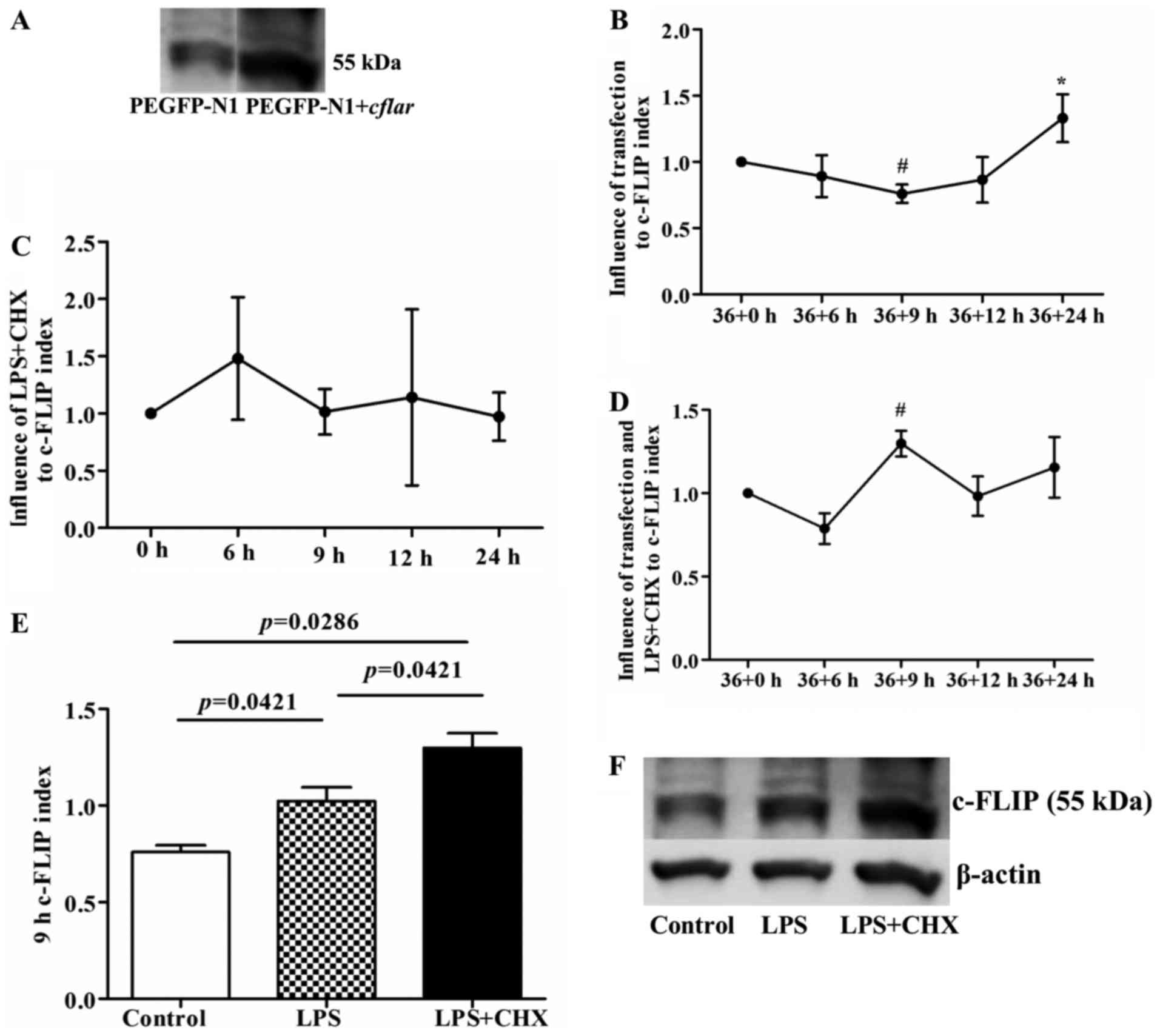|
1
|
Yu JW and Shi Y: FLIP and the death
effector domain family. Oncogene. 27:6216–6227. 2008. View Article : Google Scholar : PubMed/NCBI
|
|
2
|
Longley DB, Wilson TR, McEwan M, Allen WL,
McDermott U, Galligan L and Johnston PG: c-FLIP inhibits
chemotherapy-induced colorectal cancer cell death. Oncogene.
25:838–848. 2006. View Article : Google Scholar : PubMed/NCBI
|
|
3
|
Yan T, Li Q, Zhou H, Zhao Y, Yu S, Xu G,
Yin Z, Li Z and Zhao Z: Gu-4 suppresses affinity and avidity
modulation of CD11b and improves the outcome of mice with
endotoxemia and sepsis. PLoS One. 7:e301102012. View Article : Google Scholar : PubMed/NCBI
|
|
4
|
Wang W, Zhao F, Fang Y, Li X, Shen L, Cao
T and Zhu H: Glycyrrhizin protects against porcine endotoxemia
through modulation of systemic inflammatory response. Crit Care.
17:R442013. View
Article : Google Scholar : PubMed/NCBI
|
|
5
|
Krautwald S, Ziegler E, Tiede K, Pust R
and Kunzendorf U: Transduction of the TAT-FLIP fusion protein
results in transient resistance to Fas-induced apoptosis in vivo. J
Biol Chem. 279:44005–44011. 2004. View Article : Google Scholar : PubMed/NCBI
|
|
6
|
Bagnoli M, Canevari S and Mezzanzanica D:
Cellular FLICE-inhibitory protein (c-FLIP) signalling: A key
regulator of receptor-mediated apoptosis in physiologic context and
in cancer. Int J Biochem Cell Biol. 42:210–213. 2010. View Article : Google Scholar : PubMed/NCBI
|
|
7
|
Bannerman DD and Goldblum SE: Mechanisms
of bacterial lipopolysaccharide-induced endothelial apoptosis. Am J
Physiol Lung Cell Mol Physiol. 284:L899–L914. 2003. View Article : Google Scholar : PubMed/NCBI
|
|
8
|
Bannerman DD, Eiting KT, Winn RK and
Harlan JM: FLICE-like inhibitory protein (FLIP) protects against
apoptosis and suppresses NF-kappaB activation induced by bacterial
lipopolysaccharide. Am J Pathol. 165:1423–1431. 2004. View Article : Google Scholar : PubMed/NCBI
|
|
9
|
Karahashi H, Michelsen KS and Arditi M:
Lipopolysaccharide-induced apoptosis in transformed bovine brain
endothelial cells and human dermal microvessel endothelial cells:
The role of JNK. J Immunol. 182:7280–7286. 2009. View Article : Google Scholar : PubMed/NCBI
|
|
10
|
Rittirsch D, Huber-Lang MS, Flierl MA and
Ward PA: Immunodesign of experimental sepsis by cecal ligation and
puncture. Nat Protoc. 4:31–36. 2009. View Article : Google Scholar : PubMed/NCBI
|
|
11
|
Livak KJ and Schmittgen TD: Analysis of
relative gene expression data using real-time quantitative PCR and
the 2(−Delta Delta C(T)) method. Methods. 25:402–408. 2001.
View Article : Google Scholar : PubMed/NCBI
|
|
12
|
Hunt MA, Currie MJ, Robinson BA and Dachs
GU: Optimizing transfection of primary human umbilical vein
endothelial cells using commercially available chemical
transfection reagents. J Biomol Tech. 21:66–72. 2010.PubMed/NCBI
|
|
13
|
Safa AR, Day TW and Wu CH: Cellular
FLICE-like inhibitory protein (C-FLIP): A novel target for cancer
therapy. Curr Cancer Drug Targets. 8:37–46. 2008. View Article : Google Scholar : PubMed/NCBI
|
|
14
|
Perlman H, Pagliari LJ, Georganas C, Mano
T, Walsh K and Pope RM: FLICE-inhibitory protein expression during
macrophage differentiation confers resistance to fas-mediated
apoptosis. J Exp Med. 190:1679–1688. 1999. View Article : Google Scholar : PubMed/NCBI
|
|
15
|
Coletta C, Módis K, Oláh G, Brunyánszki A,
Herzig DS, Sherwood ER, Ungvári Z and Szabo C: Endothelial
dysfunction is a potential contributor to multiple organ failure
and mortality in aged mice subjected to septic shock: Preclinical
studies in a murine model of cecal ligation and puncture. Crit
Care. 18:5112014. View Article : Google Scholar : PubMed/NCBI
|
|
16
|
Ostrowski SR, Haase N, Müller RB, Møller
MH, Pott FC, Perner A and Johansson PI: Association between
biomarkers of endothelial injury and hypocoagulability in patients
with severe sepsis: A prospective study. Crit Care. 19:1912015.
View Article : Google Scholar : PubMed/NCBI
|














